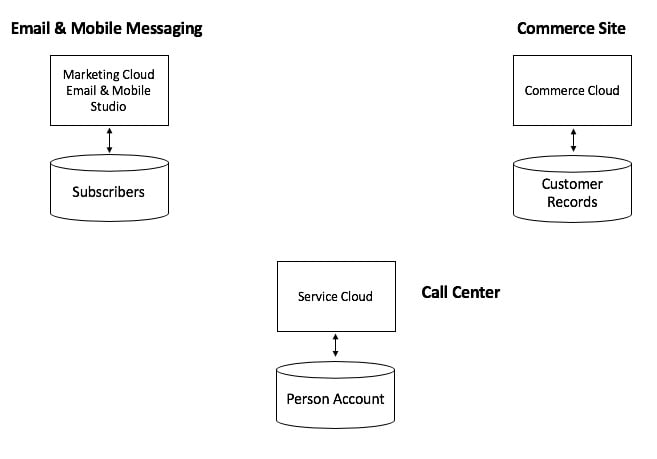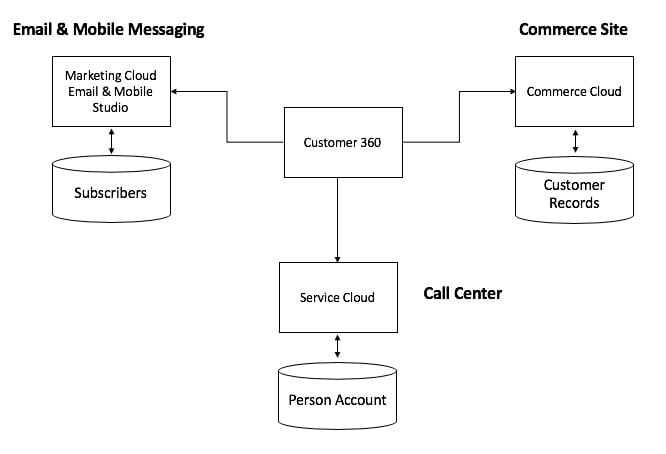[ad_1]

The B2B side of Salesforce has always had a single data model of customers across the Sales Cloud, Service Cloud, Pardot and other components.
But that hasn’t been the case for the B2C side, where brands themselves had to implement the platform connectors to tie together different customer records across applications for point-to-point connectivity. In the default use of the platform, a customer service agent couldn’t always see a consumer’s previous purchases, or an email with a product offer could go out to a consumer who had recently purchased that same product.
To support a unified consumer experience, Salesforce is releasing a closed pilot of Customer 360, which maps B2C customer records from Service Cloud, Marketing Cloud and Commerce Cloud into one master view. The new capability is expected to be available generally next year.
Before and after, graphically. Here is Salesforce’s diagram of how its B2C components have previously handled customer profiles:

And here’s how profiles will be handled post-Customer 360:

Not a customer data platform. This isn’t a customer data platform (CDP), Senior Director of Product Marketing Ron Pereira said in an interview.
Instead, he described Customer 360 as a “federated solution.” That’s an appropriate term because that the B2C side, like the federal republic of the US, came together as a series of discrete acquisitions — in this case ExactTarget, Demandware and other purchases instead of states. As SVP Patrick Stokes said recently:
People talk about a “single” view of the customer, which implies all of this data is stored somewhere centrally, but that’s not our philosophy. We believe strongly that a graph of data about your customer combined with a standard way for each of your applications to access that data, without dumping all the data into the same repository, is the right technical approach.
There is no central storage, but a kind of meta profile that accesses core attributes of each customer but not every web site click or email open. It is, Salesforce said, a “canonical data model that provides a single representation of data for all connected systems.”
The customer data remains in its respective systems, called upon when needed. Additionally, the Anypoint Platform from Salesforce’s recent MuleSoft acquisition provides APIs that can retrieve customer data from external systems.
A single Customer 360 ID ties together the separate IDs in each cloud or application, and marketers determine which data will be linked and shared — as well as defining the rules of data management, such as exact matches versus fuzzy matches — via an administrative panel.
How this changes Salesforce for B2C. The company gives the use case example of a marketer in Service Cloud who wants to change a customer’s order in Commerce Cloud. Following configuration in the admin panel, the marketer can now modify the order data in Commerce Cloud inside Service Cloud. Or the marketer could resend email promotions in Marketing Cloud, while inside Service Could.
In addition to the uber-profile/ID and admin panel, Salesforce is also announcing journey templates that let marketers automatically trigger standard journey paths, such as sending this email after a cart abandonment, followed by this mobile message. Previously, the paths would have been set up manually.
This story first appeared on MarTech Today. For more on marketing technology, click here.
About The Author

Barry Levine covers marketing technology for Third Door Media. Previously, he covered this space as a Senior Writer for VentureBeat, and he has written about these and other tech subjects for such publications as CMSWire and NewsFactor. He founded and led the web site/unit at PBS station Thirteen/WNET; worked as an online Senior Producer/writer for Viacom; created a successful interactive game, PLAY IT BY EAR: The First CD Game; founded and led an independent film showcase, CENTER SCREEN, based at Harvard and M.I.T.; and served over five years as a consultant to the M.I.T. Media Lab. You can find him at LinkedIn, and on Twitter at xBarryLevine.
[ad_2]


